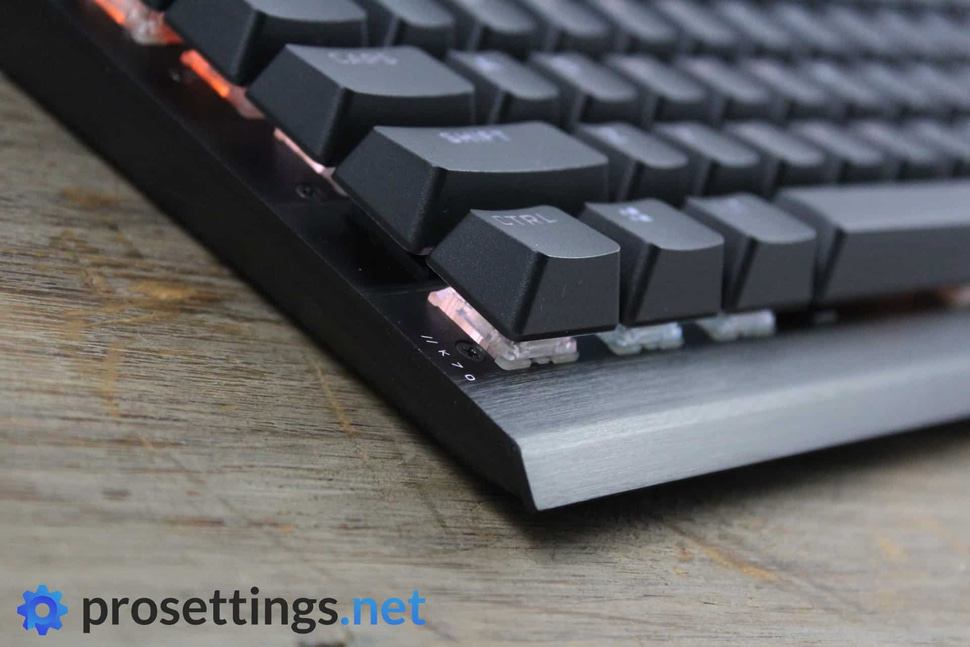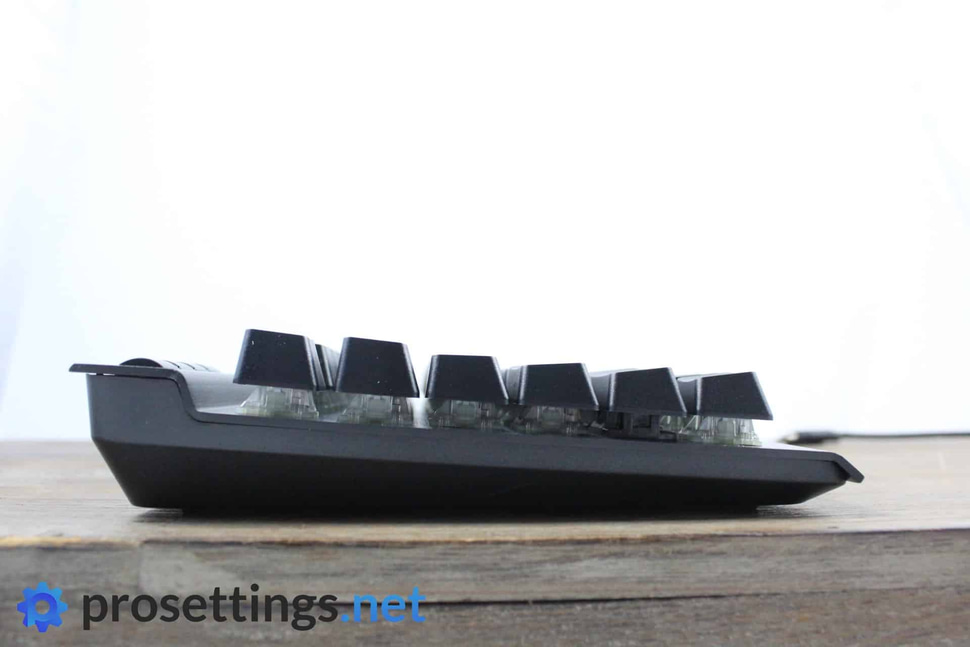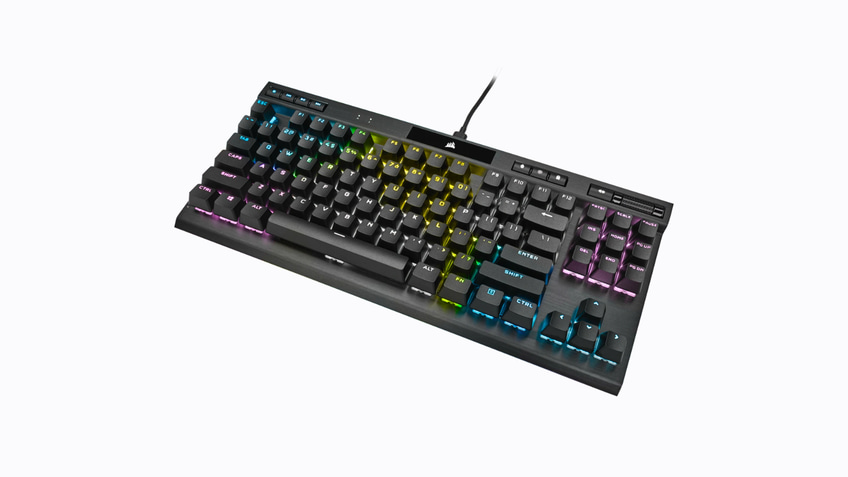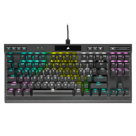Introduction
Corsair’s Champion Series is a line of products that’s made with competitive gamers in mind. Along with the Sabre Pro, Corsair’s first 8000 Hz polling rate mouse, the company also released the K70 RGB TKL: a tenkeyless keyboard aimed at the competitive crowd that also boasts a max polling rate of 8000 Hz.
Complete with PBT keycaps, a detachable cable, and dedicated media keys, this seems to be the perfect marriage between a premium full sized keyboard and a smaller, tournament-ready keyboard. We’ve sent one over to our reviewer to find out if it actually is.
At A Glance
Corsair K70 RGB TKL
Used by 2 players ()The Corsair K70 RGB TKL is a nice marriage between a fully decked out, full size keyboard and a smaller TKL board. With its detachable USB-C cable it successfully marries the portability of smaller form factors with the luxury of big boards, and the inclusion of PBT keycaps and the standard of finishing make this a really solid purchase.
Pros
- Solid PBT keycaps
- Detachable cable makes it a lot more portable
- Nice marriage between portability and features such as media buttons and a volume rocker
Cons
- Loud
- Rattly stabilizers
Specs
| Form Factor | TKL |
|---|---|
| Switches | Cherry MX Speed, Cherry MX Red |
| PCB | Non-Hotswappable |
| RGB | Yes |
| Height | 3.9cm |
| Width | 36.0cm |
| Length | 16.5cm |
| Weight | 931g |
First Impressions
One of the first things that caught my eye is the fact that this K70 RGB TKL (I’ll refer to it as the ‘K70’ every now and again) has a detachable cable. In my eyes that aids immensely with portability, and it’s not something that you often see on these fully decked out TKL boards. The fact that it’s USB-C means that you don’t have to worry about breaking or losing the cable, and as an added bonus it also allows you to use custom keyboard cables since the connector port isn’t proprietary.
Aside from that it’s good to see that Corsair have gone for premium materials and components here: sometimes on these smaller boards you see manufacturers go for lower grade components, but that’s not the case here. The K70 RGB TKL comes with PBT keycaps, the signature Corsair brushed aluminum top plate, and a full set of media keys, including a dedicated volume roller.

Those of you who’ve already used a premium tier Corsair keyboard will be familiar with this one: the housing is made out of plastic while the top portion is made out of Corsair’s signature brushed aluminum. This gives the whole thing a sturdy feeling and a sleek, almost stealthy look. Whether you like that or not will obviously depend on your preferences, but the whole thing does give off an air of quality.
As we’ve also come to expect from Corsair, the RGB is beautiful. The keycaps do a good job at letting the light through and the slightly shiny aluminum ever so slightly reflects the glow of the RGB LEDs which gives the board an extra touch. The options to tweak the lighting are also near limitless (more on the software later) so if you’re someone who’s into RGB this will definitely suit you.
Packaging
Inside the box you will find the usual documentation, the keyboard, a set of textured MOBA and FPS replacement keycaps, a keycap puller and then of course the detachable USB-C cable. This cable is braided to give it a more premium look and feel but luckily it’s not overly stiff or thick, which is nice. As I mentioned before you can easily replace it with any USB-C cable you have lying around as well.
What’s cool is that they’ve included some additional textured keycaps (these are ABS though, not PBT) and a keycap puller. Tiny little extras like that can make the package seem much more appealing, and especially something like a keycap puller is a great tool to have, even if you don’t plan on replacing the caps. Corsair is always on top of their game when it comes to these little extras, and it’s nice to see.
Features and Build
One of the selling points of this board (at least in my opinion) is the fact that it has a smaller form factor without making any sacrifices when it comes to functionality. If you’re someone who doesn’t like a full size keyboard for space reasons but you do like your media keys and all of that other jazz then this could be right up your alley.
You’ve got the usual stop, skip, play/pause, and mute buttons, and buttons to switch profiles, change the lighting, and disable the Windows key. Along with that you also have a volume roller that’s got some lovely texturing to it and feels great to use; it doesn’t have tangible steps but it’s got just the right amount of resistance to make it feel very nice and smooth to operate without it feeling flimsy or loose. All of these buttons can also be reassigned should you want to use them for something else.

The included keycaps are made out of PBT, which feels a lot better to type on than (cheap) ABS caps if you ask me, and it also drastically reduces the amount of shine the keys will develop after use. This switch from cheap(er) ABS keycaps to PBT keycaps is something that’s happening all across the mass produced keyboards industry, and it’s a change that I really like. The font on the caps is perhaps a bit too ‘gamery’ for me, but that’s a subjective opinion.
On the bottom of the board there are four very large rubber feet (with cutouts for the two flip up feet in the top feet) and those do a great job at keeping the board in place, even on slippery surfaces. The feet also have a rubberized element to them but it’s not quite as sticky as the ‘main’ feet. I didn’t have any issues using the board with the feet flipped up, but it is something odd that I noticed.
On the back of the board you’ll find a ‘tournament switch’ which turns the RGB to red and disables macros and what not so you can focus fully on whatever game you’re playing. Features like these aren’t exactly something that I personally use but then again my default lighting settings aren’t very distracting, so if you’re someone who uses flashy effects and a bunch of macros when browsing this gaming mode can definitely be handy.
Performance and Everyday Usage
The board that I have tested came with Cherry MX Speed switches, but you can also get this board with Red switches. A notable omission here are Corsair’s very own OPX switches that we saw on the K100. Since this is pretty much a premium board it’s kind of a strange decision to me that Corsair doesn’t allow you to buy it with their own version of speedy switches but it is what it is.
In any case: the Cherry MX Speed switches that are on this board do their job as they should. They’re decently smooth, and their low actuation point of 1.2 mm makes them feel a bit faster than their Red counterparts from the same manufacturer. I am personally more of a fan of tactile switches these days, but I have to say that I quite like the Speeds as far as linears go.

The board is pretty darn loud, however. There’s also some case ping here and there (depending on how hard you hit the key and which key you’re hitting) so the K70 RGB TKL is not the most pleasant sounding mass produced board out there. What’s kind of weird is that the stabilizers for the space bar actually sound pretty good (and the space bar is often the area where a lot of manufacturers mess up) but the other keys (such as enter and backspace) have a ton of rattle to them. That’s a bit of a shame, doubly so because the space bar does sound very acceptable. I’m not in the habit of comparing boards like this to custom made keyboards that cost multiple Benjamins but even when compared to other mass produced boards the stabs disappoint a bit here.
Moving on to the 8000 Hz polling rate, then. In the gaming mouse scene this has been a topic of hot debate, with some people claiming that it absolutely makes you a better player whilst others say it’s just placebo, but for a keyboard it doesn’t really make a lot of sense at this point in time. Keyboard entries are more ‘binary’ anyway; you either press a key or you don’t, whereas mice are continuously moving and need to be as smooth as possible on screen. As such, the advantages of using a polling rate of 8000Hz on a keyboard aren’t as pronounced as they can be with a mouse.
I don’t mean that Corsair shouldn’t include this technology, though. Despite the fact that I can’t feel a difference between 8000Hz and 1000Hz on a keyboard, the inclusion of the higher polling rate doesn’t hinder the board in any way, so as far as I’m concerned this is all good. Just don’t go around buying this board thinking you’ll become a master KZ player in CS:GO, for example.
Despite the fact that you can do a good amount of controlling on the keyboard itself you will need Corsair’s iCUE software if you want to get the most out of it. That has seen some updates and has received a visual overhaul, but it’s still not the most easy to use program out there. Once you’ve gotten over the learning curve the possibilities are close to endless but you will be spending some time getting to grips with all of its quirks and features.
Sound Test
Conclusion
The Corsair K70 RGB TKL is a nice marriage between a fully decked out, full size keyboard and a smaller TKL board. With its detachable USB-C cable it successfully marries the portability of smaller form factors with the luxury of big boards, and the inclusion of PBT keycaps and the standard of finishing make this a really solid purchase.
It is a rather loud board, however, and some of the stabilizers (minus the space bar) sound very rattly, so there’s definitely room for improvement. If you can live with those things and you’re looking for this type of ‘compromise’ board between TKL and full size then this is a great option. Including the ability to use it with a polling rate of 8000Hz is nice, but ultimately that doesn’t result in any tangible ingame advantage if you ask me, so don’t let that decide your purchase.
This product was received for free from the manufacturer and given to our reviewer to test and review. Brands and manufacturers have no editorial control over our reviews. For more information, check out our review FAQ.










Alright, got it.
Thanks for explaining, sounds good.
You have, for example some fast 240 Hz monitor, smartphone which can shoot at at least 700 fps and a single player game with fast input (at let’s say stable 300 fps)?
A simple somewhat “methodological” test would be to drop a 100 grams metal (or your favorite bar of chocolate) ball from 5 cm onto a button (actuation force of 60 g), which would be enough.
Travel distance, pre-travel, actuation point etc. would be included in such kind of test, and from exactly 5 cm, the travel speed would be basically the same.
The reaction would then be seen on the monitor. Some tedious pixel/frame-counting later 😀 and the results would be comparable.
Battlenonse is basically doing the same, only more methodological and accurately repeateable.
Will await some new reviews ^.^
Well different reviewers/websites have different focuses of course. There are reviewers who focus almost exclusively on the technical aspects of a product, for example, whereas you also have reviewers that focus almost solely on how a product feels and looks on a surface level. I try to be somewhere in between, which is a style that seems to be welcomed by a lot of people. By this I don’t mean that I am ‘better’ than others or anything like that: every reviewer is different and speaks to a different audience. Someone who wants to know everything there is to know about the internals of a product isn’t going to watch or read a reviewer who spends 50% of the review talking about the RGB, for example. And vice versa. I probably won’t ever be a hyper technical reviewer but I will certainly try to come up with some adequate comparisons when it comes to speed boards. Thanks again for the explanation and suggestions, I’m always keen to learn!
What for me lacks in your keyboard reviews is the speed aspect; the comparisons, be it in some objective form of testing (keypresses with bloody’s sofware), some slow motion video recording, or at least some meticulously subjective testing.
When I switched from some duck gaming keyboard with cherry mx reds to the a4 tech bloody B975 with optical-mechanical lightstrike (LK) brown switches, the difference was day and night.
As an experienced afps players, the speed difference was noticeable (tested in single player/multiplayer). The same switches Razer is using and other brands.
For speed, things matter as travel distance, actuation point, switch height, keyboard polling rate, linear/tactile but also the software implementation.
It would be nice if you could start write about those things.
Would like to know if there is some improvement over the bloody b975, that would be noticeable.
I try to discuss speed when I review keyboards with switches that are tailored for that kind of stuff, but in reality a lot of people don’t really notice any huge difference/care more about switch feeling as opposed to the speed: we see pros switch from boards with speed-oriented switches to boards with more traditional switches all the time, for example. Also vice versa, but the point I’m trying to make is that a super fast switch isn’t necessarily objectively ‘better’; things like fat fingering etc. can also have an impact on gameplay. As such I tend to not judge keyboards on how fast they are: these reviews are not focused purely on switch/keyboard speeds since it’s rather subjective.
Of course a keyboard with optical switches tailored for speed will feel a lot faster and more responsive than a board with heavy tactile switches aimed at typing enthusiasts, but even then ‘speed’ is difficult to objectively quantify. Do you count the travel before actuation? If yes there’s a problem with how much force/speed you’re using to press the keys, as that varies between players. If no then you’re already neglecting a crucial part of how a switch feels when using it in reality, and actual switch response times (if you’re ignoring travel etc.) are so close that it’s almost impossible to feel ingame. As you said: travel distance, actuation, height, matter the most for how fast a switch feels.
That said: I do see your point regarding speed-oriented keyboards, and when I review the next speed-focused board I’ll take some time to compare it to other options on the market to see if I can actually feel a difference (between speed boards: I am absolutely not debating that speed boards feel a lot faster than slow tactile boards, foe example). One more note: I am not experienced in AFPS games so your experience might vary. I have never tried the Bloody B975 (nor have I ever heard of it before now) either so I’m afraid I can’t make comparisons to that board as of right now.